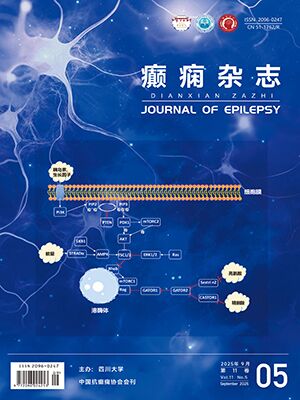| 1. |
Friedman D, Honig LS, Scarmeas N. Seizures and epilepsy in Alzheimer's disease. CNS neuroscience & therapeutics, 2012, 18(4): 285-294.
|
| 2. |
Haussmann R, Mayer T, Schrempf W, et al. Alzheimer's disease and epilepsy. Der Nervenarzt, 2017, 88(9): 1003-1009.
|
| 3. |
Kim DY, Carey BW, Wang H, et al. BACE1 regulates voltage-gated sodium channels and neuronal activity. Nature cell biology, 2007, 9(7): 755-764.
|
| 4. |
Lehnert S, Hartmann S, Hessler S, et al. Ion channel regulation by β-secretase BACE1–enzymatic and non-enzymatic effects beyond Alzheimer's disease. Channels, 2016, 10(5): 365-378.
|
| 5. |
Soh H, Pant R, LoTurco JJ, et al. Conditional deletions of epilepsy-associated KCNQ2 and KCNQ3 channels from cerebral cortex cause differential effects on neuronal excitability. Journal of Neuroscience, 2014, 34(15): 5311-5321.
|
| 6. |
Scharfman HE. Alzheimer’s disease and epilepsy: insight from animal models. Future neurology, 2012, 7(2): 177-192.
|
| 7. |
趙愛云, 崔群力. 阿爾茨海默病伴發癲癇臨床分析. 中國實用神經疾病雜志, 2014, 17(14): 27-28.
|
| 8. |
Gorter JA, Van Vliet EA, Aronica E, et al. Progression of spontaneous seizures after status epilepticus is associated with mossy fibre sprouting and extensive bilateral loss of hilar parvalbumin and somatostatin‐immunoreactive neurons. European Journal of Neuroscience, 2010, 13(4): 657-669.
|
| 9. |
趙娟, 張彥妹, 鄭乃智. 癲癇和阿爾茨海默病共病機制的研究進展. 中國醫藥導報, 2017, 14(21): 53-56.
|
| 10. |
Selkoe DJ, Hardy J. The amyloid hypothesis of Alzheimer's disease at 25 years. EMBO molecular medicine, 2016, 8(6): 595-608.
|
| 11. |
Palop JJ, Chin J, Roberson ED, et al. Aberrant excitatory neuronal activity and compensatory remodeling of inhibitory hippocampal circuits in mouse models of Alzheimer's disease. Neuron, 2007, 55(5): 697-711.
|
| 12. |
Giorgi FS, Saccaro LF, Busceti CL, et al. Epilepsy and Alzheimer’s Disease: Potential mechanisms for an association. Brain research bulletin, 2020, 160: 107-120.
|
| 13. |
熊敏, 蘇化慶, 向明鈞. 癲癇發病機制的研究進展. 中國當代醫藥, 2019, 026(030): 24-27.
|
| 14. |
Lei M, Xu H, Li Z, et al. Soluble Aβ oligomers impair hippocampal LTP by disrupting glutamatergic/GABAergic balance. Neurobiology of disease, 2016, 85: 111-121.
|
| 15. |
Verret L, Mann EO, Hang GB, et al. Inhibitory interneuron deficit links altered network activity and cognitive dysfunction in Alzheimer model. Cell, 2012, 149(3): 708-721.
|
| 16. |
Toral-Rios D, Pichardo-Rojas PS, Alonso-Vanegas M, et al. GSK3β and Tau Protein in Alzheimer's Disease and Epilepsy. Frontiers in Cellular Neuroscience, 2020, 14: 19-19.
|
| 17. |
Tai XY, Koepp M, Duncan JS, et al. Hyperphosphorylated tau in patients with refractory epilepsy correlates with cognitive decline: a study of temporal lobe resections. Brain, 2016, 139(9): 2441-2455.
|
| 18. |
DeVos SL, Goncharoff DK, Chen G, et al. Antisense reduction of tau in adult mice protects against seizures. Journal of Neuroscience, 2013, 33(31): 12887-12897.
|
| 19. |
Decker JM, Krüger L, Sydow A, et al. The Tau/A152T mutation, a risk factor for frontotemporal‐spectrum disorders, leads to NR 2B receptor‐mediated excitotoxicity. EMBO reports, 2016, 17(4): 552-569.
|
| 20. |
Kanekiyo T, Bu G. Apolipoprotein E and Amyloid-β-independent mechanisms in Alzheimer’s disease//Genes, environment and Alzheimer's disease. Academic Press, 2016: 171-196.
|
| 21. |
Amit K, Manjari T, Pandey RM, et al. Apolipoprotein E in temporal lobe epilepsy: A case-control study. Disease Markers, 2014, 22(5-6): 335-342.
|
| 22. |
Liang Y, Zhou Z, Wang H, et al. Association of apolipoprotein E genotypes with epilepsy risk: A systematic review and meta-analysis. Epilepsy & Behavior, 2019, 98: 27-35.
|
| 23. |
Jonsson T, Atwal JK, Steinberg S, et al. A mutation in APP protects against Alzheimer’s disease and age-related cognitive decline. Nature, 2012, 488(7409): 96-99.
|
| 24. |
Snider BJ, Norton J, Coats MA, et al. Novel presenilin 1 mutation (S170F) causing Alzheimer disease with Lewy bodies in the third decade of life. Archives of Neurology, 2005, 62(12): 1821-1830.
|
| 25. |
Watanabe H, Imaizumi K, Cai T, et al. Flexible and accurate substrate processing with distinct presenilin/γ-secretases in human cortical neurons. eNeuro, 2021, 8(2): 1-20.
|
| 26. |
de Haan W, Mott K, van Straaten EC, et al. Activity dependent degeneration explains hub vulnerability in Alzheimer's disease. Plos Computational Biology, 2012, 8(8): e1002582-e1002582.
|
| 27. |
Stefanovski L, Triebkorn P, Spiegler A, et al. Linking molecular pathways and large-scale computational modeling to assess candidate disease mechanisms and pharmacodynamics in Alzheimer's disease. Frontiers in Computational Neuroscience, 2019, 13: 54-54.
|
| 28. |
Lopes MA, Junges L, Woldman W, et al. The role of excitability and network structure in the emergence of focal and generalized seizures. Frontiers in Neurology, 2020, 11: 74-74.
|
| 29. |
Stam CJ, De Haan W, Daffertshofer A, et al. Graph theoretical analysis of magnetoencephalographic functional connectivity in Alzheimer's disease. Brain, 2009, 132(1): 213-224.
|
| 30. |
Badhwar AP, Tam A, Dansereau C, et al. Resting-state network dysfunction in Alzheimer's disease: a systematic review and meta-analysis. Alzheimer's & Dementia:Diagnosis, Assessment & Disease Monitoring, 2017, 8: 73-85.
|
| 31. |
Woldman W, Schmidt H, Abela E, et al. Dynamic network properties of the interictal brain determine whether seizures appear focal or generalised. Scientific reports, 2020, 10(1): 1-11.
|
| 32. |
Tait L, Lopes MA, Stothart G, et al. A Large-Scale Brain Network Mechanism for Increased Seizure Propensity in Alzheimer's Disease. bioRxiv, 2021, Aug11;17(8): e1009252.
|
| 33. |
Arnaldi D, Donniaquio A, Mattioli P, et al. Epilepsy in neurodegenerative dementias: A clinical, epidemiological, and EEG study. Journal of Alzheimer's disease:JAD, 2020, 74(3): 865-74.
|
| 34. |
康慧聰, 朱遂強. 阿爾茨海默病與癲癇的關聯性研究. 內科急危重癥雜志, 2018, 24(3): 3-5+13.
|
| 35. |
劉真真, 曾可斌. 阿爾茨海默病伴發癲癇的研究進展. 中國實用神經疾病雜志, 2019, 22(23): 112-117.
|
| 36. |
王棟梁, 宋海棟, 許可, 等. 新型抗癲癇藥物臨床應用研究. 中國醫學科學院學報, 2019, 41(4): 566-571.
|
| 37. |
M?kinen J, Rainesalo S, Raitanen J, et al. The effect of newer antiepileptic drugs in combination therapy. Epilepsy research, 2017, 132: 15-20.
|
| 38. |
Sanchez PE, Zhu L, Verret L, et al. Levetiracetam suppresses neuronal network dysfunction and reverses synaptic and cognitive deficits in an Alzheimer's disease model. Proceedings of the National Academy of Sciences of the United States of America, 2012, 109(42): 16774-16775.
|
| 39. |
Belcastro V, Costa C, Galletti F, et al. Levetiracetam monotherapy in Alzheimer patients with late‐onset seizures: a prospective observational study. European journal of neurology, 2007, 14(10): 1176-1178.
|
| 40. |
Cumbo E, Ligori LD. Levetiracetam, lamotrigine, and phenobarbital in patients with epileptic seizures and Alzheimer’s disease. Epilepsy & Behavior, 2010, 17(4): 461-466.
|
| 41. |
Rowan AJ, Ramsay RE, Collins JF, et al. New onset geriatric epilepsy: a randomized study of gabapentin, lamotrigine, and carbamazepine. Neurology, 2005, 64(11): 1868-1873.
|
| 42. |
Cretin B. Pharmacotherapeutic strategies for treating epilepsy in patients with Alzheimer’s disease. Expert opinion on pharmacotherapy, 2018, 19(11): 1201-1209.
|
| 43. |
Giorgi FS, Guida M, Vergallo A, et al. Treatment of epilepsy in patients with Alzheimer’s disease. Expert review of neurotherapeutics, 2017, 17(3): 309-318.
|




